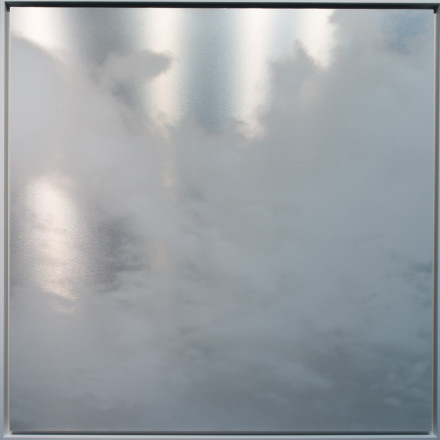Through Feb. 17, Miya Ando brings her dreamlike minimalist art to the Nancy Toomey Fine Art gallery located in San Francisco’s Minnesota Street Project.
Pieces in the show include a new series of paintings on aluminum entitled Yoake (Dawn), ink on aluminum, called Kumo (Cloud) as well as works on paper, Gekkou (Moonlight).
Ando’s inspiration derives from the Japanese word Oborozuki, meaning “the moon obscured by clouds.” The paintings in the Oborozuki exhibition are created in various techniques utilizing mediums like ink and aluminum, and all are investigations into the transformation of the surface using reflective metals. Techniques used include dye, pigment, urethane, sanding, and gilding on various reflective materials.
Ando’s use of metal as the nature of the material is unique in that it redirects fleeting light. Mutable and mercurial surfaces change and shift as the viewers walk around the gallery space and see the art from various vantage points. This has been part of the vocabulary Ando employs to communicate and investigate our relationship to time and temporality. She explains, “My hope is that the experiential nature of the paintings will create an opportunity for the viewers to become aware of the present moment, as they encounter the transitory properties of light. Being reflective, the paintings change depending on the time of day, the seasons, and reflect the particular conditions of the space.”

Miya Ando, November Kumo (Cloud) 1, 2017, Ink on Aluminum Composite, 49.5 x 49.5 x 2 Inches Framed
Created by painting on sheets of aluminum with chemicals, Ando then manipulates the color and texture using heat, sandpaper, dyes, and other processes. Though highly industrial and technically painstaking, Ando’s works have a sacred and devotional sensibility drawn from her own cultural roots and her ongoing Buddhist practice.
As well as employing imagery derived from nature, Ando’s art also draws influence form the oldest known Japanese novel, The Tale of Genji. Written by Murasaki Shikibu, the story consists of poetic observations regarding nature by its protagonist, Lady Murasaki. The Tale of Genji, also considered the world’s first novel and a novel also written by a woman, takes as its premise the fundamental interconnectivity of all things and the awareness of passing moments that this recognition inspires. Nature functions as a source of human insight. The author’s underlying Buddhist ideas about all things being transitory is another aspect that interests Ando. “There is a relatively unknown character in the book named Lady Oborozuki (Moon obscured by clouds), and this idea of naming this exhibition after particular conditions of the moon was something I was drawn to.”




